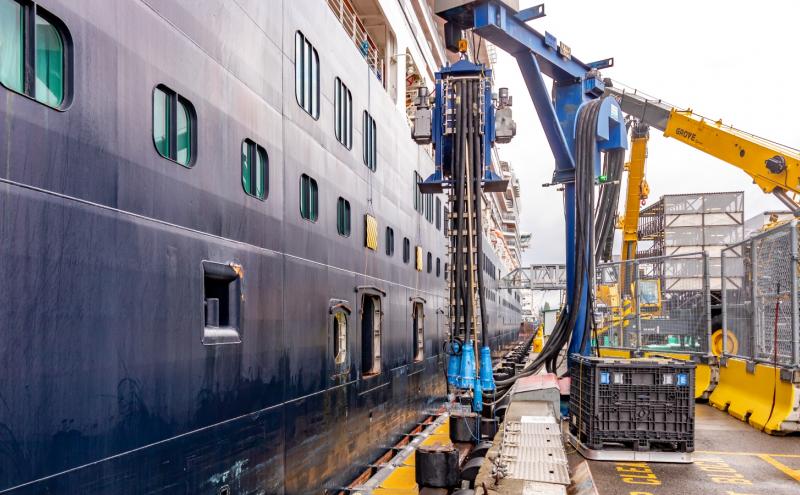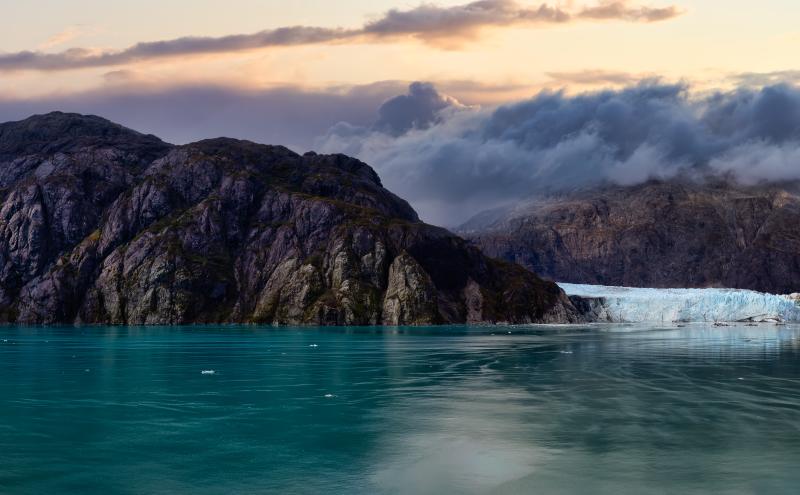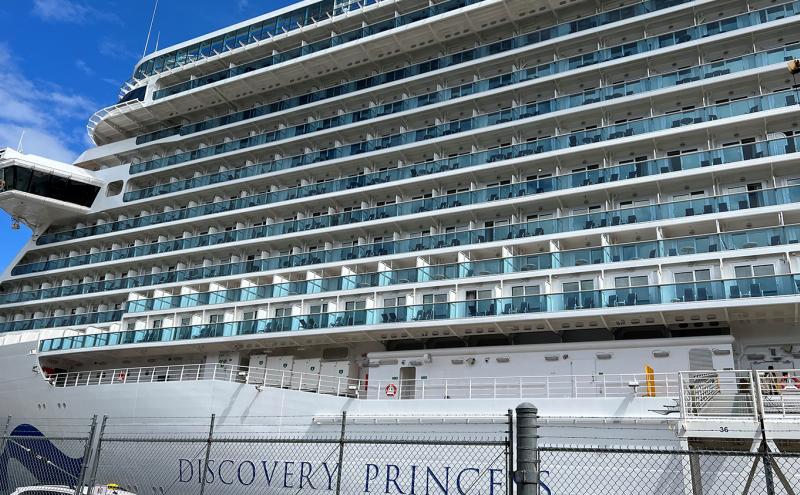
A cruise ship is, in essence, a floating city with an infrastructure that supports its residents by providing essential services like electricity, communications and connectivity, hot water, meal preparation and cleanup, flush toilets, laundry, and trash pickup. Like a city, cruise ships are also governed by legislation and standards on how to provide these essential services while protecting the natural environment.
In May, Port of Seattle staff got a behind-the-scenes glimpse of the innovative sustainability technology on Discovery Princess®, the newest ship in the Princess fleet, while docked at the Port of Seattle’s Terminal 91. Princess Cruises’ Nature and Adventure Ambassador Jeff Corwin and Discovery Princess’ Environmental Officer Biagio Del Vecchio showed us the onboard systems designed to handle and process onboard waste generated by the temporary residents of this city.
Biologist on board
Corwin is a wildlife biologist, conservationist, and animal enthusiast and has partnered with Princess Cruises for six years as the line’s Nature and Adventure Ambassador. For nearly three decades, he has been telling stories of wildlife and nature to a global audience. As the host of many long-running television shows Corwin has garnered multiple Emmy and top-broadcast industry awards. He has hosted many long-running television shows including Ocean Treks with Jeff Corwin on ABC, the Disney Channel's Going Wild with Jeff Corwin, The Jeff Corwin Experience on Animal Planet, ABC's Ocean Mysteries with Jeff Corwin, and Wildlife Nation with Jeff Corwin.
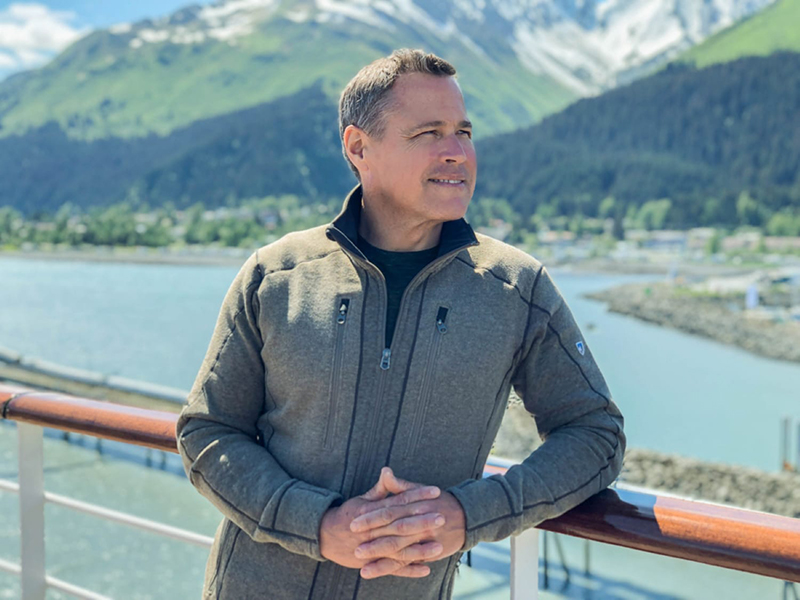
Ocean Treks with Jeff Corwin was broadcast for four seasons and took viewers to global destinations that Princess visits, including the Dominican Republic, Alaska, New Zealand, Iceland, Japan, French Polynesia, and more. Through the success of this series, Princess debuted Ocean Treks Conservation Connections, featuring short stories about unique ecosystems, environmental management, wildlife conversation, and sustainability.
Corwin’s new series, Jeff Corwin’s Alaska, introduces his favorite place to explore and highlights the wide variety of activities on Princess cruises like viewing glaciers and mountains, watching wildlife, kayaking, fishing, and more.
Reaching sustainability goals
Princess Cruises, part of Carnival Corporation, is committed to protecting the environment. In its 2022 Sustainability Report, Carnival Corporation claims to be the only major cruise company producing fewer greenhouse gas emissions today than in 2011 — despite an over 30% increase in capacity expected through 2023. And has pulled forward its stated 2030 carbon intensity reduction goal by several years, now targeting more than a 20% reduction in carbon intensity by the end of 2026 versus 2019 (and representing a 40% reduction relative to 2008. In the report, Princess outlines five environmental objectives for reducing the use of fuel, waste, and water, and for deploying solutions to provide cleaner power. (Source: 2022 Sustainability Report Executive Summary).
“Princess Cruises depends on the oceans. We are committed to environmental practices that set a high standard for excellence and responsibility and help preserve the marine environment. The ocean provides our livelihood and serves as the home for more than 25,000 of our employees.”
(Source: Princess Cruises Environmental Responsibility).
The cruise industry is highly regulated and Princess works closely with the regulatory and enforcement communities to ensure that their policies meet or exceed the strictest requirements set forth by the International Maritime Organization (IMO) and other regional and national organizations with the responsibility to protect the environment. Locally, cruise ships are regulated and inspected by the United States Coast Guard and the Washington State Department of Ecology.
John Padgett, President of Princess Cruises, reiterates the importance of meeting and exceeding these standards.
“Oceans are our business. If we don’t have healthy vibrant oceans, we won’t have a business. Our goal is to be compliant at the highest level of international standards of sustainability. And go beyond what is acceptable.”
Smart ship
The Discovery Princess is the fifteenth and newest ship in the Princess fleet and spends the winter in the Mexican Riviera and the roundtrip journey from Seattle to Alaska in the summer. This ship has the highest guest capacity in the fleet to date, with 1,830 cabins, 3,660 guests, and 1,550 crew members.
According to Corwin, the ship is the “largest smart city that just so happens to be on the water.”
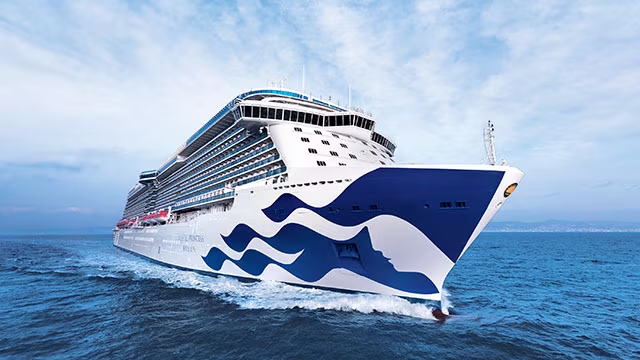
Green tech innovation
Corwin recites the Princess Cruise motto: “Our jobs are to protect, respect, and connect with the environment.” Corwin adds “and we use technology as our aid.”
Princess has spent approximately $25 million per ship in updates. Discovery Princess was designed from the ground up for sustainability using innovative technologies. All of the fleet’s older ships have been updated with biodigesters, water creation and filtration systems, waste management solutions, and more efficient propellers.
Biagio Del Vecchio, the dedicated environmental officer for Discovery Princess, is charged with monitoring the operation of onboard sustainability measures and complying with Princess standards and all international, federal, state, and local environmental regulations. Corwin and Del Vecchio provided a tour of the ship’s environmental technology detailed below.
Improved fuel efficiency
- The ship floats on a stream of bubbles to decrease drag and increase fuel efficiency
- Engines and propellers were re-engineered to consume less fuel
In a video, Corwin and Princess President John Padgett provide a first-hand look at Princess’ commitment to energy-efficient ship technologies.
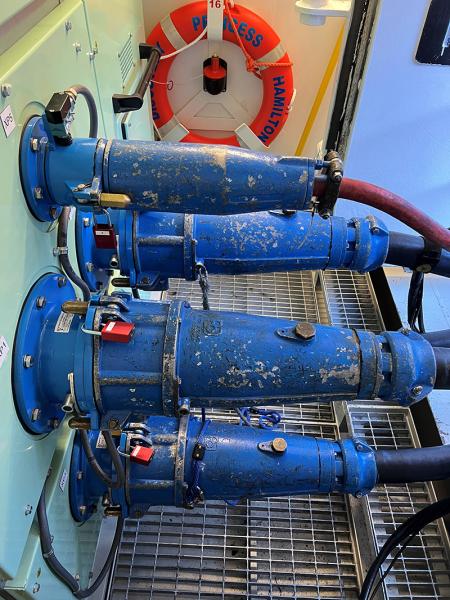
Curbing emissions
Shore power plug
Princess Cruises pioneered the use of shore power in the cruise industry in 2001 in Juneau, Alaska. This technology allows cruise ships to turn off their diesel engines, allowing a reduction of emissions and noise in the port. All 17 Princess ships (FYI — there are currently 15 ships operating in the Princess fleet with two under construction to be delivered in early 2024 and mid-2025) are outfitted with this custom-built electrical connection that’s used in six cities on the West Coast. In Seattle, the Discovery Princess plugs into the Port’s electrical system at berth, allowing them to shut off their diesel engines and significantly reduce emissions and noise during the 10-hour layover at the dock.
- Read about shore power at the Port of Seattle
Waste management
Another challenge for cruise ships is managing waste generated by ship operations and passengers in a limited space. Princess has demonstrated innovation in the projects below.
Eliminating single-use plastics
Discovery Princess has reduced single-use plastics by 90%. According to Corwin, “It’s changing the culture by having alternatives to plastics aboard the ship.”
According to the cruise line,
Princess strictly adheres to the laws which prohibit the disposal of plastic materials at sea. Over time Princess has re-designed its food, supplies purchasing and packaging requirements to cut down on the number of plastic items that are brought onboard. Plastic has been replaced by other biodegradable materials or eliminated altogether as much as possible. For example, laundry bags have been switched from plastic to paper that can be either recycled or incinerated.
(Source: Princess Cruises Environmental Responsibility)
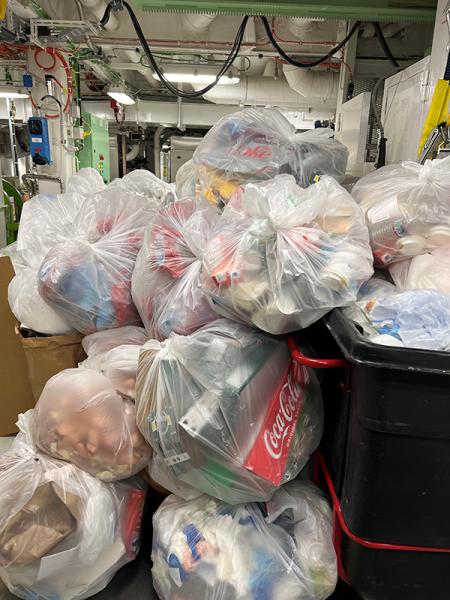
Recycling onboard materials
The ship collects and recycles a variety of materials including paper, cardboard, glass, aluminum cans, electronic waste, scrap metal, tin cans, and wood pallets.
The first step is separating all materials. Cruise guests start that process by putting their trash into recycling bins for glass, aluminum, and paper products.
Next, specially-trained staff separate and process all materials in the onboard recycling center. Here’s a glimpse of just a few materials, how they are processed, and where they end up:
- Bottles are crushed into sand for use in golf courses
- Cooking oil begins a new life as biodiesel to fuel more efficient vehicles
- 500 aluminum cans are compacted into one flat board (to reduce their volume by 85%) that are later offloaded for recycling
- Plastics are pressed into blocks used in onshore construction projects
Watch a video with Jeff Corwin and Princess President John Padgett on onboard waste management
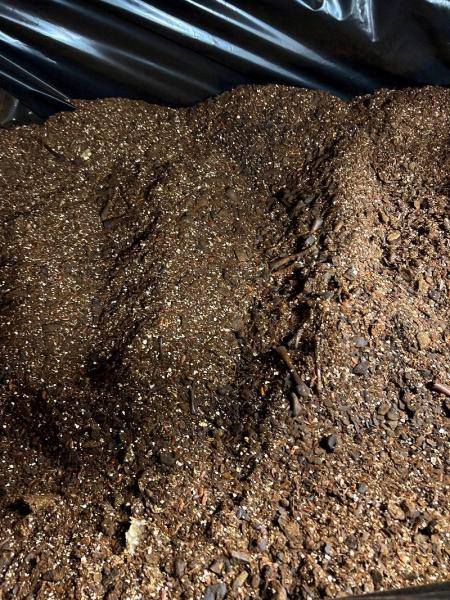
Composting food waste
To cut down on uneaten food, Princess changed their dining strategy to focus on quality over quantity and decreased the amount of food waste by 33%. The ship also features state-of-the-art technology to dehydrate and break down leftovers onboard the ship.
Step 1. The reclaimed food waste is dehydrated to remove the moisture.
Step 2. Food scraps are put into a machine that digests and breaks down organic matter. Princess uses a process to collect food waste from the dining room and then uses a sophisticated biodigester that uses microbes and other bacteria to break down organic material into sterile compost the consistency of coffee grounds that can be used on land to plant gardens.
At the time of the tour, the Discovery Princess was composting one-third of food waste but will soon be composting 100% of the ship’s organic waste.
Corwin is excited about the potential to extend this innovation from the ship to onshore applications.
“There have been leaps and bounds movements in this space that allow me with great confidence to work with Princess. I’m excited about the potential of sharing this technology for future applications. You can take this biodigester that was developed for the ship and apply it to a restaurant community on land to decrease food waste.”
Onboard waste treatment plant
The ship also has a state-of-the-art waste treatment plan to clean and purify wastewater, including used water captured from showers, sinks, laundry facilities, and kitchen equipment like dishwashers – and even toilet water.
Greywater
The plant processes greywater from showers, sinks, laundry facilities, and kitchen equipment like dishwashers.
Blackwater
Blackwater comes from anything flushed and undergoes different treatments.
Corwin details the process in a nutshell.
“We are able to use biochemistry technology and organisms along with the state-of-the-art engineering technology to process all of that waste to the point where we end up with water as pure as municipal water.”
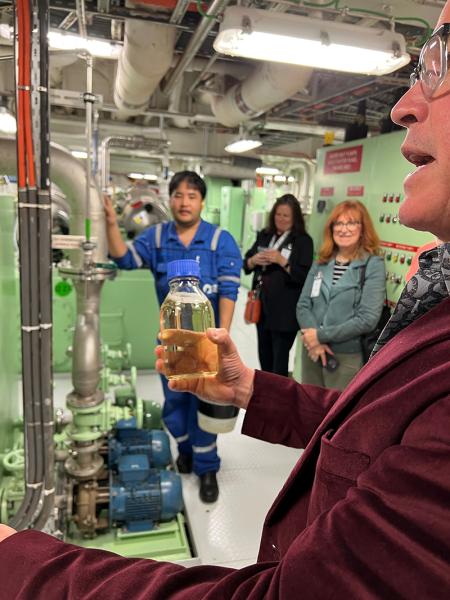
Here’s how it happens:
Step 1: Toxins are digested by naturally occurring microorganisms that feed on waste and clean the water
Step 2: The processed water is filtered through fine membranes
Step 3: It’s then sterilized with Ultraviolet light
Step 4: The water emerges as clean, safe, and sterile water with no smell or taste
Step 5: The sterile drinking water is released into the deep ocean, but never in environmentally sensitive or coastal areas. Every two weeks the water released by the ship is tested by a third party to ensure it complies with all regulations, and the results are reported to the U.S. Environmental Protection Agency (EPA).
Fact: Cruise ships, including Princess, do not release wastewater in Puget Sound or Washington state waters since they voluntarily signed a Memorandum of Understanding in 2004.
Environmental monitoring and compliance
OneOcean monitoring system
The cruise industry is one of the most regulated with myriad international, national, state, and local guidelines and regulations. Princess Cruises' policies and practices often exceed government regulations. Every ship has a state-of-the-art compliance monitoring system called OneOcean that collects all regulations for the specific location and pulls them together on a color-coded map-based interface. Officers can see at a glance that the ship is complying with or exceeding all environmental standards for that location.
According to Corwin, “It’s the brain of the ship. This is where we can keep track of everything. It’s like a traffic light. It tells us to use extra caution here because it’s a whale migration zone. It brings in all of the regulations as we go from Canada to Alaska to Washington. And we are able to stay compliant.”
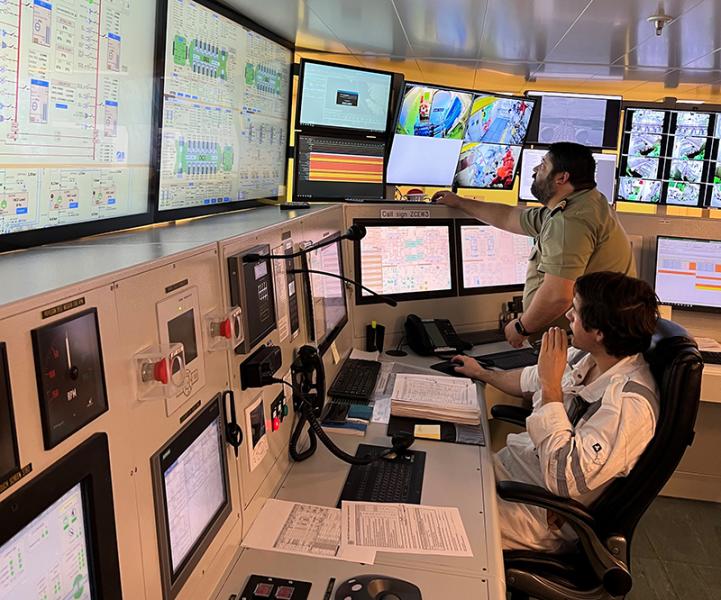
Water processing
One of the challenges for every oceangoing vessel is getting and carrying enough water at sea. Water is heavy and can shift and affect the ship’s balance. People on ships need drinking and washing water, and they come from two different sources:
Drinking water
Also called bunkered water, this is potable drinking water purchased from port communities and stored in designated potable water holding tanks. Princess bunkers water from ports where water is plentiful, high in quality, and less expensive than the fuel needed to produce water onboard. This water meets the World Health Organization and the U.S. Public Health Service standards on all cruise ships coming into and out of U.S. ports.
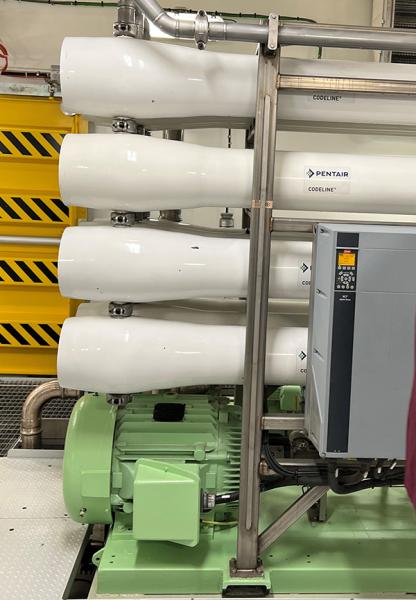
Washing water
This water is used for operating and lubricating machinery, in guest showers, and to do laundry. It can be produced in one of two ways:
Process 1. A reverse osmosis plant on the ship pulls out foreign debris and particles through a very fine membrane.
Process 2. Seawater is heated to turn it into steam. Evaporation removes the salt and 99.9% of minerals, bacteria, and other contaminants. Then it’s recaptured and cooled to produce distilled fresh water.
Ballast water
Ballast can adjust the draft of the ship (how low it sits in the water) and provide more stability in rough seas. Historically, ballast used to be stones, but it’s now seawater that cruise ships take on after releasing wastewater or unloading passengers. The ballast water is later returned to the sea when the ship is loaded again, often miles from the initial intake.
Corwin describes the process that Princess uses to protect remote and fragile environments from introduced species. The water is filtered and treated with ultraviolet light to remove microorganisms and invasive species.
“Modern ballast is water. What we don’t want to do is to unintentionally transport invasive species, large or small, from one ocean to another. For example, if this ship is going to New Zealand, they have specific requirements. We will have divers completely scrub the hull to make sure we are not taking species from one ocean to another. Our ballast is 99.9% pure because all the organisms are removed. This is important because with the places we sail, we don’t want to bring in anything that doesn’t belong there.”
Bilge water processing and monitoring
Bilge water is wastewater collected in machine spaces or collected on ship decks and could include small amounts of oil or other contaminants. All boats accumulate water in the bilge.
“Bilge is any liquid that finds itself on a deck and obviously it can’t just be dumped in the ocean. There’s a minimum industry standard for treating and purifying that water and we go beyond that standard. The industry standard for bilge water treatment is one cycle. But we put it through two treatment cycles to ensure that the water that goes into the ocean is pure,” said Corwin.
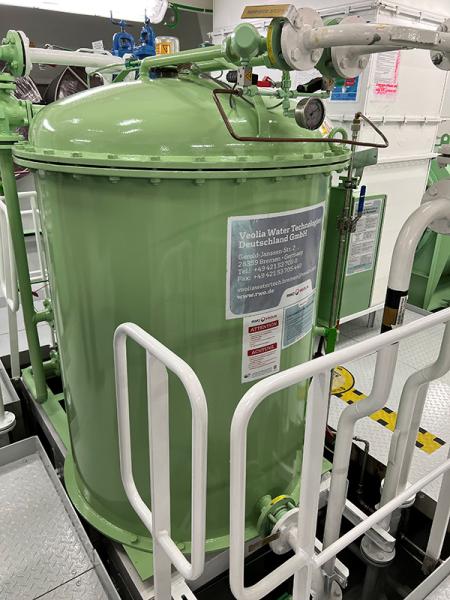
Princess carefully monitors oil release into the bilge and maintains ship machinery to prevent oil leaks into the bilge. Any oil in the bilge is separated from the water using centrifugal force until the oil content is below 15 parts per million; separated oil is carefully disposed of on land at appropriate facilities.
Here’s the process:
The bilge discharge system is constantly monitored and water will not be released overboard if it does not meet the standards of Princess Cruises and the country, state, or municipality. Access to the system is highly secure and only the environmental officer and another senior officer can approve the water’s release — and only after it is treated and purified.
Their job is to ensure it is released in an appropriate offshore location that complies with all international, regional, and national laws and regulations. Most importantly, cruise ships do not release treated and purified bilge water into Puget Sound, any ports in Alaska, or any sensitive environments.
Creating supplies from reclaimed plastics
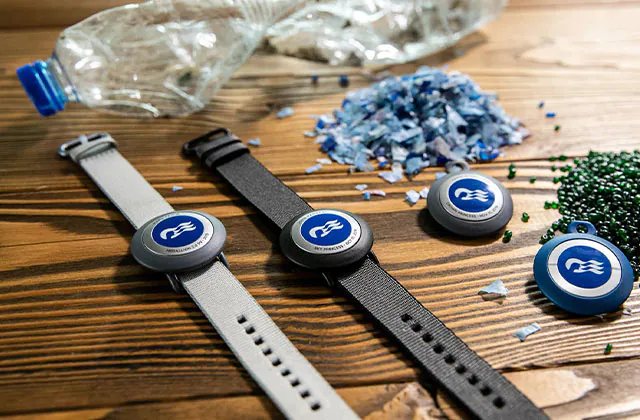
On the Princess MedallionClass ships, every guest carries a smart wearable that can provide personalized service like virtual payment, monitoring food allergies, unlocking stateroom doors, locating friends and family onboard, playing games, and navigating the ship.
Many cruisers collect these medallions and purchase accessories like necklaces, clips, wristbands, and lanyards to hold their medallions. A line of sustainable accessories is made from plastic reclaimed from the world’s oceans and coastlines. Each wrist strap is made from the equivalent of two water bottles and the clips and cases are made from post-consumer hard plastics. They’re numbered so guests can track how many plastics have been reclaimed with each device.
Bringing it home
Corwin emphasizes the value of showing guests about what’s happening behind the scenes.
“We are able to take all these little moments that you are seeing and we go through these cool things that are happening on the ship so the guests have a good idea of what we’re doing.”
He’s also passionate about the powerful impacts of education on long-term behavior change.
“I’ve had the great fortune to have sailed on just about every Carnival-branded ship in 50 different countries. My mission was to rethink your experience as a passenger with a direct focus on opportunities where you can help. Like helping build a coral reef in the Dominican Republic. Visiting a women-run cooperative at a cacao plantation. Or meeting Susan, a sustainable oyster farmer in Croatia. It shows you that there’s an opportunity in your own experience to be more sustainable.”
For these cruisers, bringing home and adopting a sustainability mindset might be the best vacation souvenir of all.

